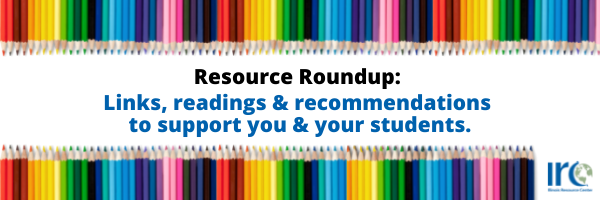 |
Over the past few months, the IRC has asked members of our community to nominate Illinois teachers working with multicultural, multilingual students who are going above and beyond, and now, we’re celebrating them and highlighting their work. Keep an eye out for these features in the coming months – and if you’d like to nominate someone, email leanet@cntrmail.org. Next up is Liz Reyes, a high school math teacher at York High School in Elmhurst.
Says Becky Morales, who nominated her: “I wanted to let you know how awesome our EL Math teacher Liz Reyes is doing with our students. We teach at York High School in Elmhurst, and most of our students are SLIFE, most are from Guatemala, and we have created a special class to help them catch up before they take Algebra 1.
Today the kids in my resource were talking about who they have for math, etc. Andoni mentioned he had Ms. Reyes, and immediately Jesus says, ‘Oh, I love Ms. Reyes. She explains everything so well, that right when she finishes talking I already have it in my brain. I always understand it.’ And then Kevin joined in: ‘Yeah I will tell you the truth. She is the best math teacher we have had. She explains math so clearly, so you have to understand it.’ Everyone at the table was nodding and agreeing. It was so sweet and genuine, and they were so enthusiastic about her, I just wanted to share!”
The first week of this school year, her first at York High School, Liz Reyes started her math class with a geography lesson.
In an effort to get to know her students, many of whom are SLIFE (Students with Limited or Interrupted Formal Education) students from Guatemala, she took the time to get to know their background and culture. Using Google Earth, her students showed her their hometowns, and she showed them the town in Mexico where her parents grew up. Together, they built the foundations of a classroom culture built on exchange and shared language. “I love that I know three or four little pueblos in Guatemala and how to pronounce them correctly,” Reyes says. “I think even if you’re a monolingual teacher and you learn a phrase a week, I think that’s so awesome and it’s a great way to connect with your students.”
Reyes teaches a special pre-algebra course for newcomer students to prepare them for high school algebra. The majority of concepts are taught in Spanish, with the additional goal of encouraging the students to meet language goals and use academic language in English. The class employs a lot of visual learning, and uses an online program with good Spanish translation for enrichment activities. Reyes says she will facilitate assignments and conversations to practice their English using math vocabulary.
Reyes says her students are eager to learn English, but she attributes the class culture they have created together with their success and comfort level collaborating, not being afraid to make mistakes as they learn and translanguaging. She translanguages with her students to model and normalize the practice, and her students will correct her if she makes a mistake translating a math term into Spanish. “I have made it a norm in our classroom because translanguaging is okay,” she says. “It’s not a disadvantage. We’re thinking in two different languages.”
That strong classroom culture manifests in other ways, too. Reyes says she takes the time to get to know her students and for her students to get to know her, not just in the context of math skills, but as people. She says she tries to give honest answers when students ask her questions about the “real world,” and she’s open about her own experiences growing up in the American school system. “Even though I was born here, I was an EL kid until I started learning English in 4th grade,” she says. “We have that in common. I know how hard it was.”
Through that mutual respect, honesty and classroom culture, Reyes and her students have worked together to create a unique, memorable environment where everyone is learning and growing. Her main advice to educators working with newcomer and SLIFE students? Take the time to get to know their language and their culture, even if it’s one phrase at a time. “We go into teaching to help our kids,” she says. “I think it makes it easier. It has its challenges but it creates a crazy awesome environment where your students are eager to learn from you.”


